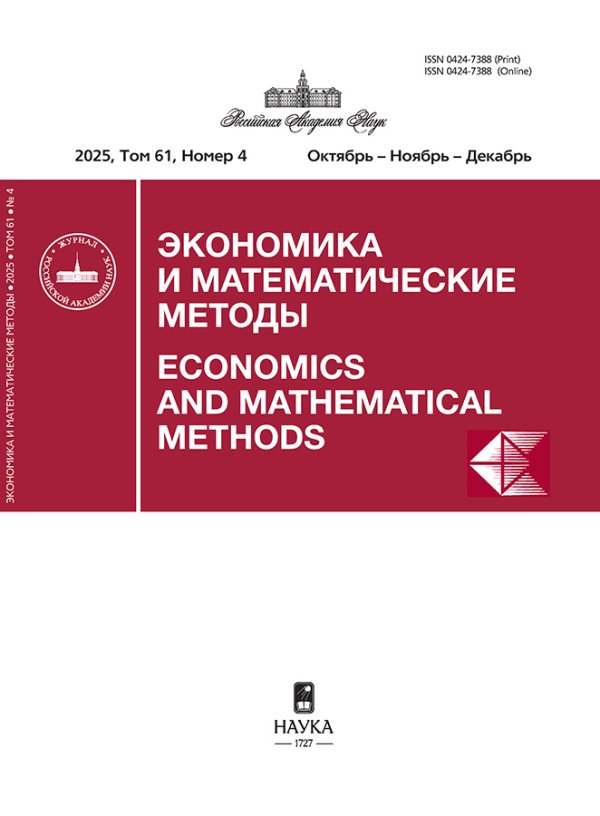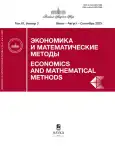Оценка финансового заражения фондовых рынков России, США, Китая и стран Европы в 2019–2024 гг. с использованием метода копул
- Авторы: Малкина М.Ю.1, Осей В.В.2, Гаврилова Е.Д.2, Флорес Туко К.С.2, Лукашина М.А.2
-
Учреждения:
- Центр макро- и микрэкономики
- ННГУ им. Н. И. Лобачевского
- Выпуск: Том 61, № 3 (2025)
- Страницы: 28-42
- Раздел: Мировая экономика
- URL: https://gynecology.orscience.ru/0424-7388/article/view/691403
- ID: 691403
Цитировать
Полный текст
Аннотация
Ключевые слова
Об авторах
М. Ю. Малкина
Центр макро- и микрэкономики
Email: mmuri@yandex.ru
Нижний Новгород, Россия
В. В. Осей
ННГУ им. Н. И. Лобачевского
Email: osejveronika@gmail.com
Нижний Новгород, Россия
Е. Д. Гаврилова
ННГУ им. Н. И. Лобачевского
Email: yekaterinagavrilova01@gmail.com
Нижний Новгород, Россия
К. С. Флорес Туко
ННГУ им. Н. И. Лобачевского
Email: florestucokimberlysarahi@gmail.com
Нижний Новгород, Россия
М. А. Лукашина
ННГУ им. Н. И. Лобачевского
Email: missis.lukashina03@mail.ru
Нижний Новгород, Россия
Список литературы
- Артамонов Н. В., Ивин Е. А., Курбацкий А. Н., Фантаццини Д. (2021). Введение в анализ временных рядов: учебное пособие для вузов. Вологда: ВолНЦ РАН. 134 с. Режим доступа: https://clck.ru/3AtL3H [Artamonov N. V., Ivin E. A., Kurbatskii A. N., Fantazzini D. (2021). Introduction to time series analysis: A tutorial for universities. Vologda: VolSC RAN. 134 p. Available at: https://clck.ru/3AtL3H (in Russian).]
- Благовещенский Ю. Н. (2012). Основные элементы теории копул // Прикладная эконометрика. Т. 26. № 2. С. 113–130. [Blagoveschensky Y. N. (2012). Basics of copula’s theory. Applied Econometrics, 26 (2), 113–130 (in Russian).]
- Бусыгин С. В., Шарыпов Р. О. (2019). Применение копул в многомерном анализе обменных курсов на примере развивающихся стран Европы // Мир экономики и управления. Т. 19. № 3. C. 58–72. doi: 10.25205/2542-0429-2019-19-3-58-72 [Busygin S. V., Sharypov R. O. (2019). Copula approach in multivariate exchange rate analysis of developing countries in Eastern Europe. World of Economics and Management, 19 (3), 58–72. doi: 10.25205/2542-0429-2019-19-3-58-72 (in Russian).]
- Кендысь А. М., Труш Н. Н. (2024). Применение моделей копул в анализе акций фондового рынка // Информатика. Т. 21. № 2. С. 24–35. doi: 10.37661/1816-0301-2024-21-2-24-35 [Kendys A. M., Troush M. M. (2024). Application of copula models in stock market analysis. Informatics, 21 (2), 24–35. doi: 10.37661/1816-0301-2024-21-2-24-35 (in Russian).]
- Пеникас Г. И. (2010а). Модели «копула» в приложении к задачам финансов // Журнал Новой экономической ассоциации. № 7 (7). C. 24–44. [Penikas H. I. (2010). Financial applications of copula-models. The Journal of the New Economic Association, 7 (7), 24–44 (in Russian).]
- Пеникас Г. И. (2010б). Модели «копула» в управлении валютным риском банка // Прикладная эконометрика. № 1 (17). C. 62–87. [Penikas H. I. (2010). Copula models in bank currency risk management. Applied Econometrics, 1 (17), 62–87 (in Russian).]
- Пеникас Г. И., Симакова В. Б. (2009). Управление процентным риском на основе копулы-GARCH моделей // Прикладная эконометрика. № 1 (13). С. 3–36. [Penikas H. I., Simakova V. B. (2012). Interest rate risk management based on copula-GARCH models. Applied Econometrics, 1 (13), 3–36 (in Russian).]
- Правдухин М. М. (2019). Применение копула-функций в управлении риском портфеля акций // Финансы и бизнес. № 15 (1). С. 33–58. doi: 10.31085/1814-4802-2019-15-1-33-58 [Pravdukhin M. M. (2019). Application of copula-functions in portfolio risk management. Finance and Business, 15 (1), 33–58. doi: 10.31085/1814-4802-2019-15-1-33-58 (in Russian).]
- Фантаццини Д. (2011а). Моделирование многомерных распределений c использованием копула-функций. Часть I // Прикладная эконометрика. № 22 (2). С. 98–134. [Fantazzini D. (2011a). Analysis of multidimensional probability distributions with copula functions. Part I. Applied Econometrics, 22 (2), 98–134 (in Russian).]
- Фантаццини Д. (2011б). Моделирование многомерных распределений c использованием копула-функций. Часть II // Прикладная эконометрика. № 23 (3). С. 98–132. [Fantazzini D. (2011b). Analysis of multidimensional probability distributions with copula functions. Part II. Applied Econometrics, 23 (3), 98–132 (in Russian).]
- Фантаццини Д. (2011в). Моделирование многомерных распределений c использованием копула-функций. Часть III // Прикладная эконометрика. № 24 (4). С. 100–130. [Fantazzini D. (2011c). Analysis of multidimensional probability distributions with copula functions. Part II. Applied Econometrics, 24 (4), 100–130 (in Russian).]
- Alqaralleh H., Canepa A. (2021). Evidence of stock market contagion during the COVID-19 pandemic: A wavelet-copula-GARCH approach. Journal of Risk and Financial Management, 14 (7), 329. doi: 10.3390/jrfm14070329
- Benkraiem R., Garfatta R., Lakhal F., Zorgati I. (2022). Financial contagion intensity during the COVID-19 outbreak: A copula approach. International Review of Financial Analysis, 81, 102136. doi: 10.1016/j.irfa.2022.102136
- Bollerslev T. (1986). Generalized autoregressive conditional heteroscedasticity. Journal of Econometrics, 31 (3), 307– 327. doi: 10.1016/0304-4076 (86)90063-1
- Chen S., Li Q., Wang Q., Zhang Y. Y. (2023). Multivariate models of commodity futures markets: A dynamic copula approach. Empirical Economics, 64, 3037–3057. doi: 10.1007/s00181-023-02373-2
- Cubillos-Rocha J.S., Gomez-Gonzalez J.E., Melo-Velandia L.F. (2019). Detecting exchange rate contagion using copula functions. The North American Journal of Economics and Finance, 47, 13–22. doi: 10.1016/j.najef.2018.12.001
- Ding H., Kim H.-G., Park S. Y. (2016). Crude oil and stock markets: Causal relationships in tails? Energy Economics, 59, 58–69. doi: 10.1016/j.eneco.2016.07.013
- Engle R. F. (1982). Autoregressive conditional heteroscedasticity with estimates of the variance of United Kingdom inflation. Econometrica, 50 (4), 987–1007. doi: 10.2307/1912773
- Fenech J.-P., Vosgha H. (2019). Oil price and Gulf Corporation Council stock indices: New evidence from time-varying copula models. Economic Modelling, 77, 81–91. doi: 10.1016/j.econmod.2018.09.009
- Forbes K., Rigobon R. (2002). No contagion, only interdependence: Measuring stock market co-movements. Journal of Finance, 57 (5), 2223–2261. Available at: http://www.jstor.org/stable/3094510
- Fry R., Martin V. L., Tang C. (2010). A new class of tests of contagion with applications. Journal of Business and Economic Statistics, 28 (3), 423–437. doi: 10.1198/jbes.2010.06060
- Fry-McKibbin R., Hsiao C. Y.L. (2018). Extremal dependence tests for contagion. Econometric Reviews, 37 (6), 626– 649. doi: 10.1080/07474938.2015.1122270
- Gomez-Gonzalez J.E., Rojas-Espinosa W. (2019). Detecting contagion in Asian exchange rate markets using asymmetric DCC–GARCH and R-vine copulas. Economic Systems, 43 (3–4), 100717. doi: 10.1016/j.ecosys.2019.100717
- Jayech S. (2016). The contagion channels of July–August-2011 stock market crash: A DAG-copula based approach. European Journal of Operational Research, 249 (2), 631–646. doi: 10.1016/j.ejor.2015.08.061
- Lu Y., Xiao D., Zheng Z. (2023). Assessing stock market contagion and complex dynamic risk spillovers during COVID-19 pandemic. Nonlinear Dynamics, 111, 8853–8880. doi: 10.1007/s11071-023-08282-4
- Luo C., Liu L., Wang D. (2021). Multiscale financial risk contagion between international stock markets: Evidence from EMD–Copula–CoVaR analysis. The North American Journal of Economics and Finance, 58, 101512. doi: 10.1016/j.najef.2021.101512
- Nelsen R. B. (2006). An introduction to copulas. 2nd ed. N.Y.: Springer-Verlag. 272 p. doi: 10.1007/0-387-28678-0
- Rodriguez J. C. (2007). Measuring financial contagion: A copula approach. Journal of Empirical Finance, 14 (3), 401– 423. doi: 10.1016/j.jempfin.2006.07.002
- Tian M., Guo F., Niu R. (2022). Risk spillover analysis of China’s financial sectors based on a new GARCH copula quantile regression model. The North American Journal of Economics and Finance, 63, 101817. doi: 10.1016/j.najef.2022.101817
- Wang H., Yuan Y., Li Y., Wang X. (2021). Financial contagion and contagion channels in the forex market: A new approach via the dynamic mixture copula-extreme value theory. Economic Modelling, 94, 401–414. doi: 10.1016/j.econmod.2020.10.002
- Wen X., Wei Y., Huang D. (2012). Measuring contagion between energy market and stock market during financial crisis: A copula approach. Energy Economics, 34 (5), 1435–1446. doi: 10.1016/j.eneco.2012.06.021
- Zhang P., Lv Z.-X., Pei Z., Zhao Y. (2023). Systemic risk spillover of financial institutions in China: A copula-DCC-GARCH approach. Journal of Engineering Research, 11 (2), 100078. doi: 10.1016/j.jer.2023.100078
Дополнительные файлы








